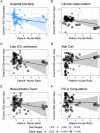Evaluating associations between patient-to-nurse ratios and mortality, process of care events and vital sign documentation on paediatric wards: a secondary analysis of data from the EPOCH cluster-randomised trial
- PMID: 38964797
- PMCID: PMC11227805
- DOI: 10.1136/bmjopen-2023-081645
Evaluating associations between patient-to-nurse ratios and mortality, process of care events and vital sign documentation on paediatric wards: a secondary analysis of data from the EPOCH cluster-randomised trial
Abstract
Objective: To describe the associations between patient-to-nurse staffing ratios and rates of mortality, process of care events and vital sign documentation.
Design: Secondary analysis of data from the evaluating processes of care and outcomes of children in hospital (EPOCH) cluster-randomised trial.
Setting: 22 hospitals caring for children in Canada, Europe and New Zealand.
Participants: Eligible hospitalised patients were aged>37 weeks and <18 years.
Primary and secondary outcome measures: The primary outcome was all-cause hospital mortality. Secondary outcomes included five events reflecting the process of care, collected for all EPOCH patients; the frequency of documentation for each of eight vital signs on a random sample of patients; four measures describing nursing perceptions of care.
Results: A total of 217 714 patient admissions accounting for 849 798 patient days over the course of the study were analysed. The overall mortality rate was 1.65/1000 patient discharges. The median (IQR) number of patients cared for by an individual nurse was 3.0 (2.8-3.6). Univariate Bayesian models estimating the rate ratio (RR) for the patient-to-nurse ratio and the probability that the RR was less than one found that a higher patient-to-nurse ratio was associated with fewer clinical deterioration events (RR=0.88, 95% credible interval (CrI) 0.77-1.03; P (RR<1)=95%) and late intensive care unit admissions (RR=0.76, 95% CrI 0.53-1.06; P (RR<1)=95%). In adjusted models, a higher patient-to-nurse ratio was associated with lower hospital mortality (OR=0.77, 95% CrI=0.57-1.00; P (OR<1)=98%). Nurses from hospitals with a higher patient-to-nurse ratio had lower ratings for their ability to influence care and reduced documentation of most individual vital signs and of the complete set of vital signs.
Conclusions: The data from this study challenge the assumption that lower patient-to-nurse ratios will improve the safety of paediatric care in contexts where ratios are low. The mechanism of these effects warrants further evaluation including factors, such as nursing skill mix, experience, education, work environment and physician staffing ratios.
Trial registration number: EPOCH clinical trial registered on clinical trial.gov NCT01260831; post-results.
Keywords: health & safety; hospitals; human resource management; mortality; nurses; paediatrics.
© Author(s) (or their employer(s)) 2024. Re-use permitted under CC BY-NC. No commercial re-use. See rights and permissions. Published by BMJ.
Conflict of interest statement
Competing interests: CSP is a named inventor of the Bedside Paediatric Early Warning System and has shares in a decision support company in part owned by SickKids that was established to commercialise the Bedside Paediatric Early Warning System. All other authors declare no potential conflicts of interest with respect to the research, authorship and/or publication of this article.
Figures


References
Publication types
MeSH terms
Associated data
LinkOut - more resources
Full Text Sources
Medical
